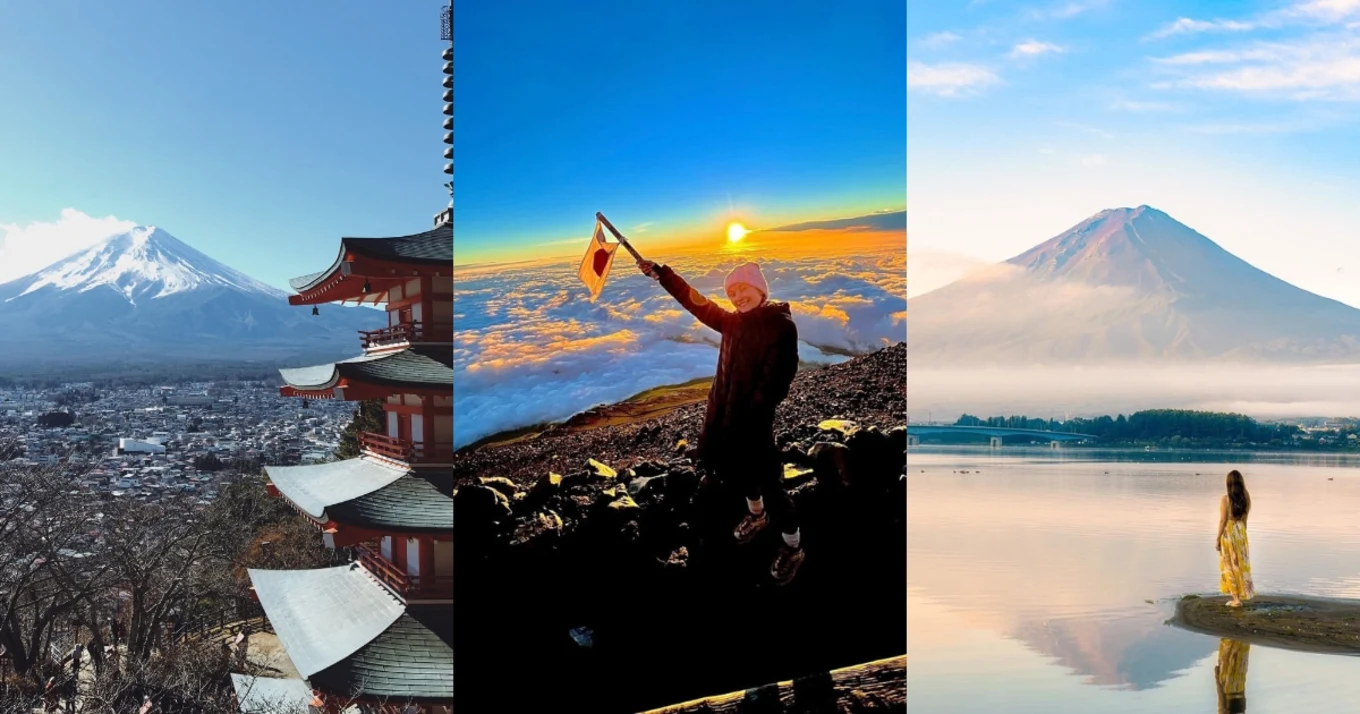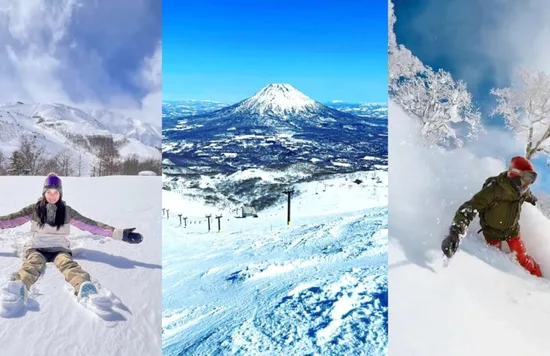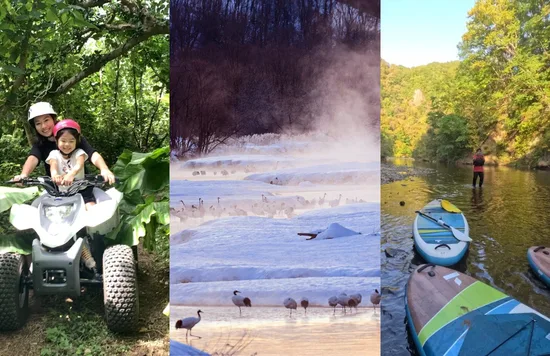There’s no doubt that Mount Fuji is a Japanese icon, just like kimonos, sushi and Hello Kitty. So if you are planning a visit and are tossing up whether or not to climb it, we’d like to help you decide.
Climbing Mount Fuji? It’s a YES from us! Here are a few handy tips to help you get the most out of your climb.
Can tourists visit Mount Fuji?
Of course! In fact, Mount Fuji attracts an average of a million tourists each year, and around 300,000 climb to the top.
If it’s your first time visiting Mount Fuji in Japan, here are a few (not-so-fun) facts you need to know:
- The mountain is often shrouded by thick clouds, causing low visibility. This usually occurs during daylight.
- You can’t camp on the mountain at all. You must stay in a hut if you intend to take an extended rest or sleep. Ensure you have cash on you before you set off, as EFTPOS terminals for cashless transactions won’t work up in the sky!
- Altitude sickness is a real thing! It can cause headaches, dizziness and nausea. Some climbers find attacking the incline more slowly helps, while others simply have to turn around and descend the mountain if the symptoms don’t abate.
- Trekking during the peak season will mean you are never too far from another group of climbers, so don’t stress too much about the ‘what ifs’. Try to enjoy the challenge ahead!
- Don’t forget to put on layers. The weather can change drastically at midday, and thunderstorms are pretty common in the afternoon.
Can a beginner climb Mount Fuji?
Mount Fuji in Japan is a beginner-friendly mountain. But we recommend joining a climbing tour instead of DIY-ing the climb though. This way, you’ll be safe with experienced climbers who’ll teach you the necessary routes and precautions. Plus, gears and safety equipment usually come with the tour, so there’s no need to buy your own.
Is climbing Mount Fuji hard?
Believe it or not, climbing Mount Fuji is relatively easy (hey, we said relatively), and there is no need for a guide if you ascend during the official season. The paths are generally broad, and the ascent is not too steep, so the most significant considerations you will face are the thinning of the air as the altitude increases and your own level of fitness.
The most popular way to climb Mount Fuji is to ascend to either the seventh or eighth station before spending the night (well, a few hours of it) in one of the mountain huts there before setting off again very early in the morning to reach the summit in time for sunrise. The huts sell food and water and offer oxygen tanks for hire. Reservations for beds are essential.
In theory, you could also continue your Mount Fuji climb to the summit from the fifth station during the night and walk until sunrise. Still, the risk of injury is significantly increased. Who wants to pay the excess on travel insurance when they could be spending that cash on fun stuff instead?
How long does it take to climb Mount Fuji?
Depending on the trail one chooses to climb Mount Fuji, the journey can take five to 10 hours nonstop. Most climbers will start from the Subaru Line 5th station, which is on average a five- to six-hour ascent to the summit.
Alternatively, you (especially if you’re a novice climber) can turn this into a two-day trip and spend a night at one of the mountain huts. Exploring Japan’s Mount Fuji will be more enjoyable if you do it at a relaxed pace.
How much would it cost to visit Mount Fuji?
During the climbing season, climbers of Mount Fuji are asked to contribute 1,000 yen per person at collection stations at each trailhead (about AUD 11). The money is used to cover some of the costs arising from the huge number of climbers that visit the mountain.
There are also fares for washroom facilities along the trail, which could be up to AUD 4 per visit. Take note that the fare could rise as you get closer to the summit!
What is the best time of year to climb Mount Fuji?
The official Mount Fuji climbing season (and the recommended time for climbers to make the trip) runs from early July to mid-September. What this means for those tackling the climb is the weather is milder, the mountain is free from snow, and it is easier to access and find a place to stay on the mountain.
It is also worth noting that a third of all Mount Fuji’s climbers are foreign tourists, which means the period during school holidays tends to be pretty busy. To avoid large crowds, it is best to attempt the climb before the school holidays begin (usually the first half of July) and on a weekday. The downside to this timing is that the weather can be unpredictable, so try to keep your schedule flexible, just in case.
Mount Fuji can be climbed during the off-season. But, from October to mid-June, there is a risk of avalanches, and you will definitely run into snow, ice, and strong winds. If you really wanna get in before peak season, some of the mountain’s huts are open a few days before the official season begins, and public transport will become more frequent, too. Please be safe!
How do I get to Mount Fuji from Tokyo?
Depending on the length of your stay, you might decide to take a train, bus, or drive to Mount Fuji.
Getting around Japan via public transport is very comfortable and convenient. The trains are clean, safe, efficient and well-priced for your service. It only takes around 40 minutes by shinkansen (bullet train) to get to the Mount Fuji area from Tokyo, so while a day trip is doable, if you want to climb the dormant volcano, it would mean having to stay at least one night, more likely two or three, in the area.
The easiest, most fuss-free option is to book a tour. That way, you’ll have an experienced guide, someone who will wake you up for the final leg of the hike - 2 am requires a serious alarm clock - plus they’ll look after all food and transport.
If you prefer to have your own car but aren’t confident about driving in a foreign country, you can hire a private transpo for up to nine people.
What else is there to do in the Mount Fuji area?
Wanna stroll through the national park? You got it!
Fuji Hakone Izu National Park is spilling over with natural beauty and offers endless opportunities to brush off the buzz of the city and become grounded once more. Hiking, camping, diving and stand-up paddle boarding are just some of the activities you can take part in. There are a million photo ops for those who like to appreciate the wonder of the outdoors from behind the lens, thanks to a high
ly diverse landscape that offers a fresh perspective each season.
If we’ve accidentally talked you out of climbing Mount Fuji, or you’re really just doing it for the ‘gram, may we suggest a scenic day tour that hits all the Insta-worthy moments, including the iconic shot across Lake Ka
waguchi to Mount Fuji?
Another option for a day trip from Tokyo to Moun
t Fuji is the Matcha Mount Fuji tour. Think picture-perfect moments, delicious (and cultural) Matcha tea to warm you up by Lake Kawaguchi, a touch of premium outlet shopping, and a visit to Oshino Hakkai’s picturesque 8 Ponds.
If you’re a sucker for a thrill ride, you will definitely want to visit Fuji-Q Highland, one of Japan’s most famous theme parks and home to Guinness World Record-holding rides for speed and height. The park is located in the Fuji Five Lake area at the northern foot of the mountain, which means optimal viewing points. For those who aren’t keen on scary rides, there are other entertaining things to do, including cultural experiences, a merry-go-round and Ferris wheel, performances and a maze.
Prefer just to relax in a hot spring? Sounds onsen-sational; let's go!
The official hotel of Fuji-Q Highland is the Highland Resort Hotel and Hot Spring, which is located right next to the amusement park. Staying at the hotel provides easy access to the park and free entry to the onsen. Not staying at the hotel? No worries, you can enjoy the hot springs for a fee.
Another hot spring resort is located in Hakone, which is part of the Fuji Hakone Izu National Park and is one of Japan's most popular tourist destinations.
How about a new Gucci handbag? Treat yourself to one of the outlet shops in the area.
At Gotemba Premium Outlets, you can pick up discounted bargains from Fendi, Prada, Balenciaga, Christian Louboutin, and Saint Laurent. Hmm, dare you climb Mount Fuji in a pair of red bottoms?
As you can see, there are heaps of things to do in the area surrounding Mount Fuji. There is far more to see and do in the region than just marvel at and climb the mountain, so you won't run out of activities!
What souvenirs can I buy from Mount Fuji?
A fun way to reminisce about your climb and replenish the calories you've burned on your hike is to stock up on some limited-edition Japanese confectionery with a Mount Fuji twist.
You have probably heard about the endless range of Kit Kat flavours available in Japan. Mount Fuji hasn't been left behind, with a strawberry cheesecake version of the famous chocolate sold in a mountain-shaped box, no less.
Cookies make a great gift to take home to friends and family, especially if they're strawberry, vanilla, green tea, Earl Grey and chocolate flavoured in the shape of tiny Mount Fujis. Fujiyama Cookie, located near Lake Kawaguchi, offers these in abundance, and we dare you to stop yourself from eating them on the trip home.
Another mountain-shaped treat comes from a Japanese establishment, Mary Chocolate. Almost too cute to eat, these mini-mountains come in chocolate and matcha flavours with a crunchy surprise.
This one is more of an acquired taste but is quintessentially Japanese. Yokan, a sweet jelly made from red beans, is a traditional dessert in Japan and is available to purchase in the form of Mount Fuji jutting into the skyline. An extensive range of flavours is available at different times of the year, making this irresistibly pretty treat even more special.
Don't like sweets? Starbucks has never shied away from festivities (pumpkin spice latte, anyone?), and outlets close to Mount Fuji are no different. Visit local stores to find unique merchandise that may be useful on your climb, including a stainless-steel water bottle.
Hello Kitty and Japan go hand in hand (or is that paw in hand?), so it's no surprise that specially designed Mount Fuji x Hello Kitty souvenirs exist in the form of pens, keyrings, plush toys and towels. It's kawaii to the power of a thousand and the perfect way to commemorate your time at Japan's most famous mountain.
Whether climbing Mount Fuji or simply travelling to the area for other activities, you're bound to have a mountain of fun either way!
Updated by: Elle David

















![[Updated] Complete List Of Official Nationwide MCO SOP 2021](https://res.klook.com/image/upload/fl_lossy.progressive,q_85/c_fill,w_160,h_104/v1633858858/blog/iso56uzsphmdguixkvzh.webp)





![[Updated] Complete List Of Official Nationwide MCO SOP 2021](https://res.klook.com/image/upload/fl_lossy.progressive,q_85/c_fill,w_410,h_264/v1633858858/blog/iso56uzsphmdguixkvzh.webp)







